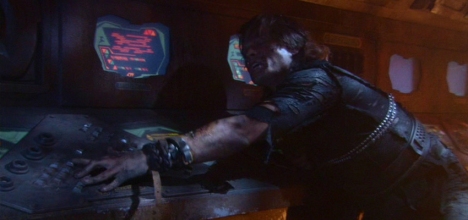Three seems to be the magic number when it comes to long-form plotting in Berman era Star Trek.
Star Trek: The Next Generation arguably pulled off a three-consecutive-episodes arc with The Best of Both Worlds, Part I, The Best of Both Worlds, Part II and Family. Even the continuity-adverse Star Trek: Voyager managed something similar with Scorpion, Part I, Scorpion, Part II and The Gift. Star Trek: Enterprise tried a number of three-episode arcs in its final season, even if only The Forge, Awakening and Kir’Shara really worked; Borderland was a preamble to Cold Station 12 and The Augments, while The Aenar was a postscript to Babel One and United.

Super villain team-up.
Three episodes seems to work quite well for Star Trek: Deep Space Nine. The series’ second season premiere was the franchise’s first bona fides three-parter, The Homecoming, The Circle and The Siege. Even when it came to longer arcs, three consecutive episodes seemed be the limit; after Call to Arms, A Time to Stand and Rocks and Shoals, the arc opening the sixth season stumbled with Sons and Daughters before regaining its footing for Behind the Lines, Favour the Bold and Sacrifice of Angels.
As an aside, it also took three episodes for the alliance between the Dominion and Cardassia to properly integrate into the show’s mythology after the events of In Purgatory’s Shadow and By Inferno’s Light; the fifth season took a pause with Doctor Bashir, I Presume, A Simple Investigation and Business as Usual before beginning to unpack the consequences of that status–quo-shattering twist in Ties of Blood and Water.

Hang loose.
There are any number of reasons why three works so well. Maybe three episodes allow for that classic three-act structure, the iconic storytelling template. Perhaps the production team on Deep Space Nine tended to work in chunks of three scripts at a time, with two or three subsequent scripts in development by the time that any given script was finished; if this was the case, it would mean that the production team was ready to start fresh with the fourth script. Whatever the reason, it is a familiar pattern.
Although “the Final Chapter” is nominally a ten-episode arc, counting What You Leave Behind as two distinct episodes, the plot beats tend to flow in discernible three-episode chunks. Ezri’s mission to rescue Worf plays out over Penumbra, ‘Til Death Do Us Part and Strange Bedfellows. Gul Rusot is introduced in The Changing Face of Evil, is built up in When It Rains…, and meets his end in Tacking Into the Wind. Bashir discovers that Odo is sick in When It Rains…, figures out Section 31 is responsible in Tacking Into the Wind, and recovers the cure in Extreme Measures.

The window of opportunity is closing.
The opening salvo of this ten-episode arc was clearly intended as a three-part story. The original titles of the episodes were Penumbra, Umbra and Eclipse, suggesting an encroaching darkness that would cast a long shadow by the end of the third episode. Coincidentally or not, that would mark the end of the first third of the larger story arc. It suggests a very formal and careful structure, suggesting a three-act structure within the first act of a three-act structure. On paper, it is a very bold and ambitious piece of structuring from the Deep Space Nine writers.
However, the production struggle to maintain that structure. These ten episodes stumble when it comes to pacing and plotting. The weakest threads in this final run are those that feel either rushed or over-extended, which struggle to hit the right beats. Strange Bedfellows is an episode that struggles because it feels like its storythreads have either been stretched or compressed, the important events either pulled back into ‘Til Death to Us Part or pushed forward into The Changing Face of Evil. The result is an episode that feels stranded between bigger story beats.

No time for reflection.
Continue reading →
Filed under: Deep Space Nine | Tagged: conservatism, ezri, Klingon, pacing, ronald d. moore, serialisation, stalling, star trek, star trek: deep space nine, strange bedfellows, the final chapter, Worf | 7 Comments »









































